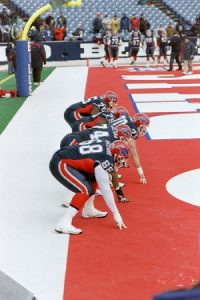 The NFL screens high-profile college athletes for speed, quickness, agility, mental aptitude, and other important traits relative to their positions. The NFL Combine with its statistical history for vertical jumps, 40 yard dash, bench press, aptitude tests, and interviews greatly increases the chances for excellent player selection. And, these are just a few of their screening tools. With a multi-million dollar investment on the line, owners make sure that due diligence occurs in the screening for new NFL players.
The NFL screens high-profile college athletes for speed, quickness, agility, mental aptitude, and other important traits relative to their positions. The NFL Combine with its statistical history for vertical jumps, 40 yard dash, bench press, aptitude tests, and interviews greatly increases the chances for excellent player selection. And, these are just a few of their screening tools. With a multi-million dollar investment on the line, owners make sure that due diligence occurs in the screening for new NFL players.
In great sales teams, the same situation exists. Each new recruit represents thousands and perhaps millions of dollars in corporate revenue. And, one recruit impacts morale, production, and the retention of other salespeople and fellow employees.
The sobering thought … coaches know that ultimately the best players get the job done on the playing field … and, they help them keep their jobs.
For these fiscal reasons, great sales managers take their candidates through some initial examination steps (Stage One: Screening). They screen by resume, by phone, by email, and perhaps face-to-face for 3-6 personality and character traits. The typical traits they screen for include: goal-orientation, social drive (for prospecting), social confidence (for prospecting, asking hard questions, presenting), and important character attributes: honesty, hard work ethic, and personal responsibility. This keeps them from spending additional recruiting dollars and interviewing time on candidates who cannot pass initial screening.
Problem … Resume reviews and reference checking alone are worth less than 4% in making good hiring decision.
After screening candidates, some candidates make it to Stage Two: Profiling. In this stage, validated profiles (see craftprofiles) are used to screen for the critical personality traits which contribute to doing important sales tasks. Also, just as in the NFL, mental aptitude is measured as well. How fast will they learn product information, paperwork requirements, marketing information, etc. for ramp up to minimum production. Scientifically validated profiles, especially ones with built in lie detectors, help isolate the traits. They are worth, in predictive measurement, between 20-50% in making a good hiring decision.
THREE PROBLEMS WITH PROFILES …
Problem #1: Many profiles are not validated.
Problem #2: Many profiles are hard to understand and very general in their reported measurements. While true, they are hard to use. Accurate information is presented in a difficult and hard to apply format.
Problem #3: Sales managers have very little practical experience with profiles, or have had a negative experience with them. They are not comfortable with how to use them.
The recruiting funnel, at its finish, narrows into the final stage – Stage 3: Interviewing. This stage may provide at least 16% of the information necessary to make a good hiring decision – if structured interviews are used. It is also the stage in which we get the participation of other team members in separate discussions and interviews.
INTERVIEW PROBLEM …
Problem: Most sales managers do interviews that are not structured to screen for the 3-6 critical traits. They also do not ask the same questions to every candidate and then score out their responses. An unstructured interview is worth less than 4% to a good hiring decision – some experts say less than 2%.
……………
An outstanding RECRUITING SYSTEM finds great salespeople …
Use multiple sources for an adequate flow of candidates. Recruit with a three stage funnel in the order outlined above: Screening, Profiling, Interviewing, and do so with critical traits in sharp focus.
As you become more proficient with the process, its tools, and skills, your selection will improve. Just like the NFL, you will use proven selection methods to separate the best from the rest – to find salespeople suited for the challenges they will face.
To impact ramp up time, first year production, and retention, recruit the best. Learn the skills. Use the tools. Follow the process.
What’s next? After hiring, the ramp up period and coaching process become important. And, that’s a message for another time. For now, Recruit the Best … and later we’ll discuss Coaching the Best. Do Great. Lance.
